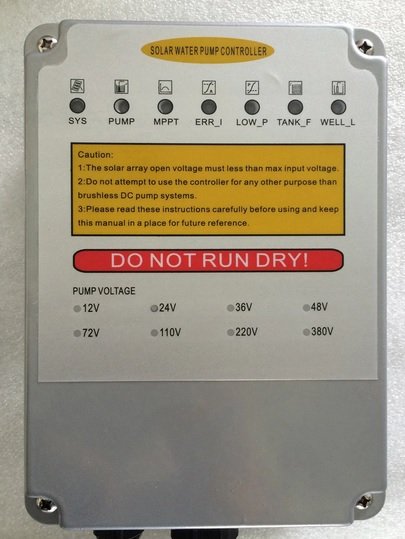
This article will tell you how to use solar panels directly without a battery.
Type of Loads
Why would you want a solar system without a battery backup?
- You only need to power loads during the day
- The loads are not critical
- You only need to power a water pump
- Batteries are too expensive
We must recognize that a solar panel’s output is inconsistent. The factors can be:
- Clouds
- Rain
- Nighttime
Expect that without sun or during bad weather, there will be no electricity to power your off-grid system. Knowing this, we can continue with the voltage we need for the system.
The Output of the System
Now that we have established that you can run a solar power system without batteries, we can plan for the appliances.
- 12V and 24V DC
- Low power 120 and 230V AC
- Pool pumps
- High power 120V and 230V AC
12V and 24V DC
You can use a DC-DC converter for a 12VDC system. Since solar panel power is DC, you can connect it directly to the converter.
Your solar panels should be wired in parallel (depending on the DC-DC converter). This will make the voltage the same while the current adds up. Visit this page for more information between series and parallel.

Let’s say you have two 100W panels in parallel with each 20V and 5Amps. The output will be 20V and 10 Amps. The DC to DC converter will have a variable voltage input. This is ideal for the application. I recommend using the following converters:
It is difficult to find a variable input converter with an output of 24V and a high enough input voltage for solar panels. If you have solar panels with a lower voltage, you can use this 10-16V input to 24V converter.
From there, you can connect your loads. But remember, you can only power them when the sun is shining.
120V and 230V AC
These loads can be for powering a few lights, fans, small tools, or a pool pump.
We will have the same setup as in the 12 and 24VDC systems, but now we will need to add an inverter.
The input voltage of a 12V inverter will be 10V to 15.5V. The problem is that the output of the solar panels does not have that low voltage. Remember our two solar panels in parallel? Let’s wire them in series now to get 200W at 40V and 5Amps.
Let’s take this DC-DC converter with an input voltage of 36-48V and converts it to 12V 30Amps.

Now you can choose a 12V inverter. Because we only have 200Watts of solar panels and the DC to DC converter has an 80-90% efficiency, we can use a cheap 150W inverter. If you want a higher power output and you have the solar power for it, then I recommend this 300W inverter.
An important part to remember is that your inverter choice depends on your combined solar panel’s power and the converter’s current rating. If you have a combined solar power array of 500W, then it doesn’t make sense to get an inverter higher than 500Watts.
Will did a great video about this explaining how it works:
Solar Power Pumps
Another application for solar power systems without a battery is a well pump. You can use these pumps for several purposes:
- Pumping water up in a reservoir for later use
- Pumping water for field irrigation
- Swimming pool pumps
In both cases, the solar panels are connected to a controller. Depending on the type of controller, you can set the timing or install a switch to turn the pump on manually. Usually, they also have an automatic off input from a float switch if you use it to fill a reservoir.

These pumps are mostly 24V or 48VDC. Depending on the controller, the input voltage can be from 20-100VDC. Your solar panels should be connected in series but under the maximum allowed voltage. If you wire 4 panels in series with each 20V and 5Amps, you will have 80V and 5A on the input of the pump controller. The voltage here is Voc (volts open circuit). You can run a 400Watt pool pump with this setup.
The controller will bring down the voltage and increase the current, just like an ordinary MPPT charge controller.
High Power Systems
The previous systems were low to medium-powered systems. What if you want to run an AC unit from the solar panels but don’t want to buy batteries?
Some grid inverters have a feature called islanding. This means that it can work without a grid and sometimes without a battery. You need to make sure you get the right inverter for this.
The AC unit will have a surge current that can draw 2-3 times as much power during the first 3 seconds of startup. Your system needs to be big enough to handle this current. To limit the effect of the surge current, you can add capacitors to the inverter. This will effectively get you through the surge startup phase but won’t power your load long-term.
One of these inverters is the Growatt SPF 3000TL LVM-ES. You can attach a battery if you want, but it is not required.

Another video from Will Prowse about this inverter.
The main takeaway is that it needs the proper input voltage, and no surge current should exist. If you have a surge current, attaching a small battery might solve the problem.
Conclusion
Can you have a solar panel system without a battery? Yes, you can. You need the right equipment to regulate the voltage into a 12V appliance or an inverter.

I’m an off-grid enthusiast. I created this website to give clear and straight-to-the-point advice about solar power. I’m also the author of the book ‘Off-grid solar power simplified‘. Read more about me on my about page, check out my Youtube channel, or send me a message.
Great article. Just what I was looking for. Thanks!
Really interesting article. Thanks.
I have about 3 kW worth of second hand panels, and I would like to build an array that charges my electric car. How could I go about that cheaply?
Cheers!
Thanks Lachie, I would recommend using the last option in the article. Using the Growatt SPF 3000TL LVM-ES without battery.
that is great will try it good research
Dear Nick,
Growatt SPF 3000TL LVM-ES device, can it work without a network connection or battery?
Thank you
The manual states it can work without a battery. Network connection is not needed, but can be useful if you want to update the firmware.
Hi Nick, thanks for the information above. I am also interested in a batteryless system for recharging an EV. I am wondering how fluctuating sun due to clouds might affect the attached equipment, when the load reduces the output voltage. Would the inverter switch off in low sun and back on when the sun returns?
There will still be power going into your EV. If there are clouds, the output is reduced, but there is still an output. When it gets dark, the output will be 0.
Thank you for the great article. I love the simplicity and link for the converter. I do have a question though regarding running panels in series. In the diagram it shows 2 100w 20v panels running in series with a 200w 40v output. Wouldn’t the wattage stay the same at 100w? In my case I would be running 4 100w 20v panels. 2 pairs of series run parallel. Would my output be 200w 40v or 400w 40v?
No, the current will stay the same when wiring in series. Wattage (power) will always increase because volts*current=power. In your case it’s 400W 40V in a 2S2P configuration.
I currently have off-grid solar as a back-up energy source for emergencies. I use 10 100-watt panels (wired for 24v) into a charge controller, into a battery array, and available for the inverter. The 4kw inverter can be plugged into a 30 amp outlet, when necessary, which is wired to my breaker box. I can run some emergency lighting, well pump, etc off this one breaker.
IF, in an extended and extreme situation, I lost battery capability, could I then connect my inverter directly to my charge controller for daytime power usage? Or, do I need to find additional equipment to use from the solar array to the inverter?
Charge controllers require a battery to charge with. Losing battery capability will be very unlikely. I would be more concerned about losing your charge controller or the inverter. I have seen people use capacitors to run an airconditioner straight from the solar panels with a hybrid inverter, but I wouldn’t rely on it.
Thank you.
I guess my bigger question is….
Can I connect my solar array directly to an inverter? Or, do I need another device between the panels and inverter?
IF so, where do I find information on the right sizing for this other device? I have 10 100-watt panels for a 24v system and a 4Kw inverter at 240 output.
BTW, you’ve got a great site going !
Hi Nick,
Thank you for a brilliant article on the topic.
I am planning to install a PV system to power a 37kW load (AC submersible pump) and want to avoid using batteries. What configuration and equipment would you recommend to use?
You need a pump controller. The pump controller replaces a battery + charge controller, but it will be a DC pump. However, I don’t think a 37kW pump controller exists for AC. Are you sure it’s 37kW?
It is an AC pump of 50HP (37kW) for a 200 meter (656 feet) well head and enough flow rate for irrigation. I have not yet been able to find a DC pump with these capabilities.
Thank you.
I guess my bigger question is….
Can I connect my solar array directly to an inverter? Or, do I need another device between the panels and inverter?
IF so, where do I find information on the right sizing for this other device? I have 10 100-watt panels for a 24v system and a 4Kw inverter at 240 output.
BTW, you’ve got a great site going !